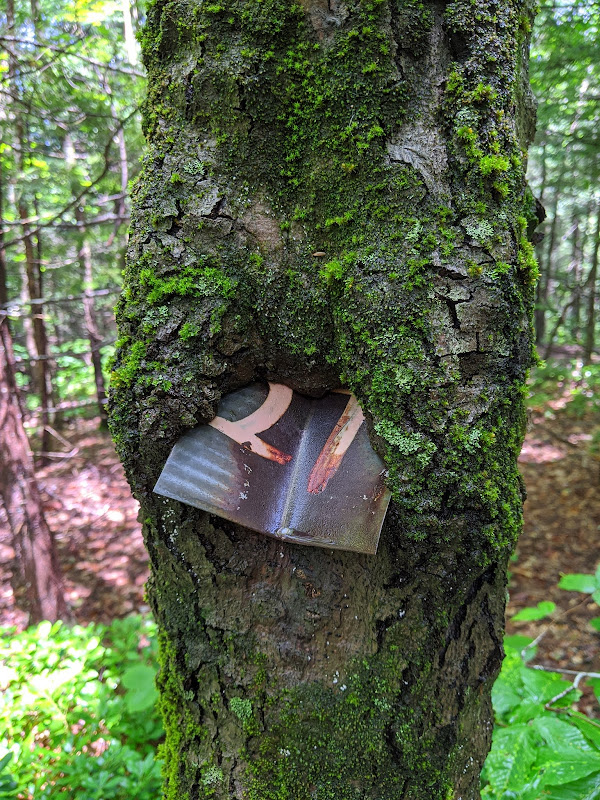Until I began investigating moss, lichens and mushrooms for this blog, I was a happily oblivious hiker escaping the heat of summer while snapping photographs of interesting things low to the cool damp earth. Oh sure, sometimes these things presented themselves higher up and sometimes they were in hot dry places, and sometimes they were flat and on "dead" things like rocks while other times they had dimension and were on living things like trees; but in my mind they were all part of one big cool family. Well as it turns out I couldn't have been more wrong.
So why personify moss with the attribute of courage? Well let's first take a look at the ways people attempt to rid their property of some of the 12,000 species of moss. I suspect the most popular method is application (who has time for hard labor when there are games of golf to be played). A moss warrior might apply Ferrous sulfate (iron) which kills moss by drying it out. Putting down lawn fertilizer bolsters plants like fescue, permitting it to out compete moss. Lime increases soil p.h. making it inhospitable. Other methods include decreasing water, increasing sunlight and disturbing it which also includes heavy traffic. Heavy traffic is particularly notable when considering the Black Gum swamps in Vernon's town forest (more on that later). Hmmm, perhaps it's not the moss that deserves the green badge of courage after all; but rather it's the property owner who is brave enough to resist an abundance of media advertisers and their attempts to embarrass land owners into eradicating it. Well as people are fond of saying when confronting these things, "follow the money."
There are parasitism, mutalism and commensalism relationships in the world of Botany. Moss is of the commensalism variety which is Geek speak for: while moss lives on trees (among other things), moss doesn't take anything from the tree. Unlike fungus, moss doesn't have roots and so does not break down nor remove nutrients from that upon which it is growing. At great risk of sounding like a plant nerd I will try to tread lightly here. As I mentioned, moss does not have roots so how and what does moss eat? Well, moss is a non vascular plant. It is short, non woody, it doesn't seed or flower and it has leaves that are one cell thick. I was told to shorten up my paragraphs, so on to the next paragraph...
Those short thin leaves are like little sponges that absorb varying amounts of water depending on the type of moss it is. Sphagnums (peat moss) for example, can absorb twenty to thirty times its weight in water! The stuff in it's leaves that makes moss green is called Chlorophyll. The magic happens when Chlorophyll traps the sun's heat energy. The energy combines with Carbon Dioxide (CO2) and water to create carbohydrates which is food for the moss. Oh my goodness I can feel your eyes glazing over already; but hang in there for a second and prepare to have your mind blown. The moss only needs the carbon from the bond to make its carbohydrate and so expels the O2 and of course O2 is none other than oxygen!
So let's recap. Moss is a bunch of leaves, that act like sponges, that take in a greenhouse gas, and in return gives us oxygen- all without breaking down or consuming whatever it is growing on. But oh my friends it gets better than that! Moss is a simple indicator species, moss is intolerant of pollution and will not grow on polluted sites. I know, how exciting can one plant get!
Consider tropical storm Isiah with all of it's twenty four hours of flash flood warnings. Now consider all of those beautiful, clean, big and small, deep and shallow, moss filled swamps within the forty one acres of moss filled town forest! Our town forest floor consists of peat and other mosses that has been measured to be eleven feet deep in spots! It's like having basins and acres of sponges at the ready and waiting to absorb storm water, slow water runoff and control erosion. The mosses at Black Gum Swamps are one of Vernon's secret weapons against flash flooding and greenhouse gas! They truly are Ninjas. Clearly protecting those swamps and the moss within to the very best of our ability is to everyone's benefit.
If you still need more on the subject than that, let me explain how I came up with the title "The Green Badge of Courage." Along with being absorbent, moss has antibacterial properties. Moss was historically used to treat infection and stop blood loss -it is an old fashioned bandage if you will. For this reason, I took liberties with the title of Stephen Cranes novel, The Red Badge of Courage.
Shall I keep going? Moss is said to to have been used to warm the blood if consumed; but some sources caution against it. It was stuffed into footwear, mittens and into gaps in homes to insulate from the cold. It was used for bedding. It was used for making diapers. Moss was part of the process for preparing fish for drying... Okay, that's enough of that! Next blog I will discuss that incredible fruit we know as mushroom.
Until then, as you wander about in Vernon be sure to tread lightly and wear your "green badge" with pride - Norma Manning
Resources:
What is Moss?? Earth Titan
7 Main Types of Moss From Around the World Homestratoshhere
Moss Wikipedia





No comments:
Post a Comment